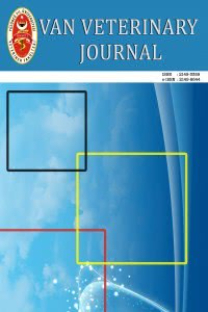Felid herpesvirus - 1 infection in Van cats with conjunctivitis
Konjunktivitli Van kedilerinde Felid herpesvirus - 1 Enfeksiyonu
___
- Bilge Dağalp S, Akça Y (2004). Detection of feline herpesvirus-1 from domestic cats with or without respiratory symptoms. Indian Vet J, 81, 11-15.
- Çabalar M, Bilge Dağalp S (2008). Feline herpesvirus-1 infection in Turkish Van cats with conjunctivitis and upper respiratory tract disease. In: XIV. International Congress of Virology, Istanbul, Turkey; pp. 288.
- Burns RE, Wagner DC, Leutenegger CM, Pesavento PA (2011). Histologic and molecular correlation in shelter cats with acute upper respiratory infection. J Clin Microbiol, 49, 2454-2460.
- Cai Y, Fukushi H, Koyasu S, Kuroda E, Yamaguchi T, Hirai K (2002). An etiological investigation of domestic cats with conjunctivitis and upper respiratory tract disease in Japan. J Vet Med Sci, 64, 215-219.
- Crandell RA, Maurer FD (1958). Isolation of a feline virus associated with intranuclear inclusion bodies. Proc Soc Exp Biol Med, 97, 487–490.
- Davison AJ, Eberle R, Ehlers B, Hayward GS, McGeoch DJ, Minson AC, Pellett PE, Roizman B, Studdert MJ, Thiry E (2009). The order Herpesvirales. Arch Virol, 154, 171-177.
- Di Martino B, Di Francesco CE, Meridiani I, Marsilio F (2007). Etiological investigation of multiple respiratory infections in cats. New Microbiol, 30, 455-461.
- Gaskell RM, Povey RC (1982). Transmission of feline viral rhinotracheitis. Vet Rec, 111, 359-362.
- Gaskell RM, Willoughby K (1999). Herpesviruses of carnivores. Vet Microbiol, 69, 73-88.
- Gaskell R, Dawson S, Radford A, Thiry E (2007). Feline herpesvirus.Vet Res, 38, 337-354.
- Harbour DA, Howard PE, Gaskell RM (1991). Isolation of feline calicivirus and feline herpesvirus from domestic cats 1980 to 1989. VetRec,128,77- 80.
- Kang BT, Park HM (2008). Prevalence of feline herpesvirus 1, feline calicivirus and Chlamydophila felis in clinically normal cats at a Korean animal shelter. J Vet Sci, 9, 207-209.
- Nakamura K, Ikeda Y, Miyazawa T, Nguyen NTP, Duong DD, Le KH, Vo SD, Phan LV, Mikami T, Takahashi E (1999). Comparison of prevalence of feline herpesvirus type 1, calicivirus and parvovirus infections in domestic and leopard cats in Vietnam. J Vet Med Sci, 61, 1313-1315.
- Pedersen NC (1987). Feline herpesvirus type 1 (feline rhinotracheitis virus). In: Appel MJ, editor.Virus infections of carnivores. Amsterdam: Elsevier Science Publishers, pp. 227–237.
- Povey RC (1979). A review of feline viral rhinotracheitis (feline herpesvirus 1 infection). Comp Immunol Microbiol Infect Dis, 2, 373– 387.
- Stiles J, McDermott M, Bigsby D, Willis M, Martin C, Roberts W, Greene C (1997). Use of nested polymerase chain reaction to identify feline herpesvirus in ocular tissue from clinically normal cats and cats with corneal sequestra or conjunctivitis. Am J Vet Res, 58, 338–342.
- Vögtlin A, Fraefel C, Albini S, Leutenegger CM, Schraner E, Spiess B, Lutz H, Ackermann M (2002). Quantification of feline herpesvirus 1 DNA in ocular fluid samples of clinically diseased cats by real-time TaqMan PCR. J Clin Microbil, 40, 519–523.
- Weigler BJ, Guy JS, Nasisse MP, Hancock SI, Sherry B (1997). Effect of a live attenuated intranasal vaccine on latency and shedding of feline herpesvirus 1 in domestic cats. Arch Virol,142, 2389-400.
- ISSN: 1017-8422
- Yayın Aralığı: 3
- Başlangıç: 1990
- Yayıncı: Yüzüncü Yıl Üniv. Veteriner Fak.
A Duplex PCR for detection of S. aureus and Staphylococcus spp. from culture and bovine milk samples
Zafer CANTEKİN, Radhwane SAIDI, HASAN SOLMAZ, Yaşar ERGÜN
Felid herpesvirus - 1 infection in Van cats with conjunctivitis
ZEYNEP KARAPINAR, ENDER DİNÇER, VEYSEL SOYDAL ATASEVEN, Mehmet KARACA
